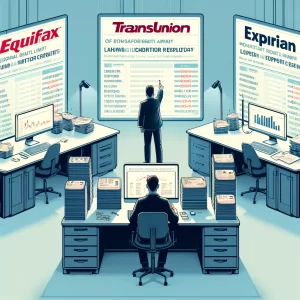Mastering Credit Management: Essentials to Maximize Your Credit Score
The majority of the links on our website are affiliate links. This means that if you click on the link and make a purchase, we earn a small commission at no additional cost to you.
3

Handling credit matters might initially appear overwhelming, but grasping the core principles can equip you with the ability to cultivate a strong financial standing. This comprehensive guide will walk you through interpreting your credit reports, rectifying any inaccuracies, and strategically boosting your credit score. Let’s commence by revisiting the basics.
Step 1: Obtain Your Credit Reports
Obtain copies of your credit reports from the three primary credit bureaus. This foundational measure is pivotal for gaining insights into your present credit situation and pinpointing any erroneous information that could be adversely influencing your financial well-being.
Step 2: Opt Out of Unsolicited Credit Offers

Safeguard your personal information and mitigate the risk of identity theft by choosing to opt out of receiving unsolicited credit card offers and loan solicitations. Furthermore, implement a credit freeze on your reports to prohibit unauthorized parties from accessing and manipulating your financial records. Any inaccuracies or inconsistencies found within these reports can have a detrimental impact on your credit score.
Step 3: Thoroughly Review Your Credit Reports
Carefully review each section of your credit reports for accuracy. Make sure they are 100% accurate and complete. Credit reports can be intimidating at first. Each one will contain the same information that includes:
- Personal Information: Your name, address, Social Security number, date of birth.
- Credit Accounts: Details of your credit accounts including banks, credit card issuers, and other lenders. This includes the type of account (mortgage, auto loan, credit card), the date you opened the account, your credit limit or loan amount, account balance, and your payment history.
- Credit Inquiries: A list of entities that have requested your credit report, such as lenders when you apply for a loan or credit card.
- Public Records: Bankruptcies, foreclosures, lawsuits, wage attachments, liens, and judgments.
- Collections: Past due accounts that have been turned over to a collection agency

Although the presentation of the information may vary, the core data remains consistent across credit reports. However, it’s important to note that not all creditors report to all three major credit bureaus. You might have a creditor that exclusively reports to Equifax, for instance. In such cases, the other two bureaus, TransUnion and Experian, would be unaware of that particular account since they have not received any information regarding it.
Creditors do not necessarily update information simultaneously. Typically, they report data around the time when your billing cycle is due, which is approximately every 30 days. The credit bureaus, on their end, will incorporate these updates anywhere from the same day to up to a week later. This discrepancy in reporting timelines is the reason why you may find one of your accounts listed on only one of your credit reports, and consequently, your credit scores may vary across the different bureaus.
Do not worry about your credit score. Technically you don’t have a credit score until your file is pulled and then it is calculated. It’s not saved, and you can’t use a previous score. Credit files change frequently. As information comes in from different sources, files are updated. Any information that is added to your file is going to impact your credit score.
There are too many factors that go into the calculation of credit scores. Your credit score is based on the information in your credit file. If your reports look good, your score will be good.
Your initial focus for review and rectification should be your personal details. This step establishes the foundation before initiating any disputes for successful credit repair. The personal identifiers to verify include:
- Your full name
- Residential address
- Date of birth
- Social Security number
- Phone number
Ensuring the accuracy of these core identifiers is crucial before proceeding with further actions.
Consistent Personal Information

Name: Regarding your name on your credit report, the objective is to have a single, consistent form listed. Or, at the very least, minimize the number of name variations present. If both your maiden name and married name appear, that is understandable, resulting in two forms being listed.
Hyphenated last names can potentially lead to confusion. Data entry errors could occur, causing inaccuracies. For instance, if I applied for a credit card using “Tom” instead of “Thomas,” but the creditor inadvertently entered “Tim” into their system, then “Tim” would be reflected on my credit report. Errors in your name and an excessive number of name variations can create issues. However, no one will proactively notify you about such errors. It is the individual’s responsibility to ensure that their credit report is 100% accurate.
Merged or mixed credit accounts are a prevalent issue, but they pose a significant problem. This error can lead to the denial of credit lines. Additionally, if the mixed account contains derogatory information, it could cost you potential job opportunities. Surnames are particularly susceptible to identity issues, errors, and merged credit files.
One of the primary reasons for minimizing name variations is to demonstrate stability. Stable individuals are less likely to default on their financial obligations.
Removing extra names from your credit reports will not only increase your score but also separate your file from those with similar names.
When eliminating names from your credit report, it’s crucial to retain accounts associated with positive credit history.
Let’s revisit the example where a creditor incorrectly entered my name as “Tim” in their system instead of “Tom.” Since no one was verifying for errors, the name on file became “Tim Smith.” However, the payment history on this account is perfect, making it an account I want to retain.
The problem arises when a lender notices the discrepancy between “Tim Smith” and “Tom Smith,” potentially raising suspicions of impropriety.
Additionally, there’s a risk that my credit file could become merged with an individual named “Tim Smith.” While I don’t want to delete this account due to its positive credit history, sending a letter demanding the removal of incorrect names could create complications.
The correct approach to resolve this issue would be to contact the creditor first and inform them of the name inaccuracy. Once the update is made, and the account is correctly tied to “Tom Smith,” I can then send a letter requesting the removal of the incorrect name variations from my credit file.
Choose one form of your name and go with it. For instance:
Thomas A. Smith Jr. – This is the most common structure for financial dealings.
- Arnold Smith Jr. -This is an alternate structure
Thomas Arnold Smith Jr. – This is another alternate structure.
- Maintain uniformity between your legal name and the one utilized across financial records and identification documents.
- If your legal name includes a suffix, ensure its consistent usage, as this will minimize the likelihood of your credit file becoming mixed with others.
- Prior to submitting applications, meticulously review and verify the accuracy of all details provided.
- Avoid the use of nicknames on legal documents to prevent potential discrepancies.
Address Discrepancies and Errors

Address: It is not uncommon for multiple addresses to be listed in your credit reports. These could include your childhood home, a rental property you resided in, or perhaps a friend’s address that you temporarily used.
However, the addresses you want to maintain on your reports are:
- Your current residential address
- Accounts associated with established positive credit history
- Properties you have owned with a mortgage that was paid on time
These types of addresses hold value for credit reports. While having a few addresses listed is normal, an excessive number, such as 10 different addresses, may raise concerns. If a lender is considering extending you a line of credit and notices several different addresses, they may question the reasoning behind such frequent relocations. The concern arises as to whether you will make the monthly payments on time if offered credit, or if you will simply change addresses, leaving the lender in a difficult situation.
Phone numbers: Verify that the phone number listed on your credit reports is your current and accurate personal phone number. Credit reports have been known to erroneously list an individual’s work phone number as their primary contact number instead of their personal number.
Social Security Number: Carefully review your Social Security number and date of birth to ensure their accuracy. Any inaccuracies or errors related to these personal identifiers can create potential problems and complications for you in the future.
Sample letter to download Sample letter
When submitting supporting documentation for identification purposes along with your dispute letters, providing more forms of identification is better than 2 forms of identification. Sending two types of ID has an acceptance rate of 76%. However, if you include three forms of ID, the acceptance rate increases to 86%. Furthermore, if you provide four forms of identification, the acceptance rate rises to an impressive 92%. This principle applies to all types of disputes you may file with the credit bureaus only.
ID types:
- Driver’s license
- Utility bill
- Bank statement
- State ID
- Voter registration card
- Personal voided check.
- Paycheck stub
- Mortgage statement
- Passport
- Rent agreement.
NOTE:
It is crucial to maintain honesty when communicating with credit bureaus. In your letter, only list the names and addresses you want to be listed on your report. It is unnecessary to give any explanation for addresses you want deleted. They only need to know what your current address is.
After submitting this letter to the major credit bureaus—Experian, Equifax, and TransUnion—it is also essential to send it to other lesser-known credit information sources to ensure comprehensive correction of your records.
LexisNexis Consumer Center
PO Box 105108
Atlanta, GA. 30348-5108
Phone: 1-888-497- 0011
__________________________
SageStream LLC
PO Box 503793
San Diego, Ca.,92150
Phone: 1-888-395-0277
Merged/Mixed Credit Accounts

The next step involves resolving merged or mixed credit files. If you do not have a mixed credit file, you can skip this information and proceed to the next step.
However, if you do have a mixed credit file, it is advisable to address this error before disputing more complex issues. At this stage, your personal identifiers should be accurate. Merged accounts are a common problem for names that include suffixes like Jr., II, or III. Those with common names or names that can be spelled differently may also experience merged accounts.
You have already determined the preferred name format you will use moving forward.
If you are certain that another person’s credit file has been improperly merged with your own, it is crucial to send a truthful and sincere letter. Include at least two forms of identification that can validate your name and address. However, remember the acceptance rate statistics mentioned earlier, which suggest providing more forms of identification increases the likelihood of acceptance.
To ensure your letter stands out and does not appear as a generic template found online, you can write “URGENT” in red at the top of the paper. This is also an opportune time to conduct a search of your first and last name. Perform a Google search for your name and observe how many individuals share the same first and last name.
Additionally, visit LinkedIn.com and enter your first and last name in the search bar. Look for the option that states “See all people results.”
If there is a significant number of individuals with the same name as yours, include this information in your letter. Incorporate a statement such as, “On LinkedIn.com alone, there are XX number of people with the same name as mine.”
Sample letter for Merged Credit Files
By now you have checked to make sure that all your personal identifiers are correct across the 3 main credit bureaus and the lesser known data collectors. And you made sure that you do not have any information that belongs to someone else in your file.
If your reports are 100% correct, then all that is left to do is review your reports annually to maintain a clean record and to stay on top of any accounts that may have been opened without your permission.
Although if you have derogatory items on your report that you want removed you can move on to the next step.